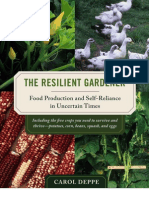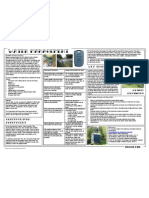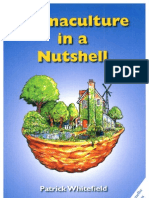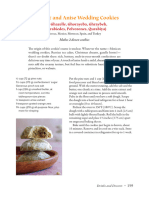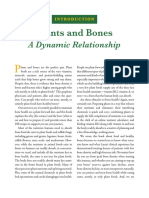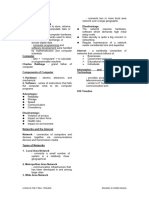0 ratings0% found this document useful (0 votes)
15K viewsDrying Prune Plums (And Figs, Apricots, Peaches, and Nectarines)
Drying Prune Plums (And Figs, Apricots, Peaches, and Nectarines)
Uploaded by
Chelsea Green PublishingThis document discusses methods for drying fruits and vegetables. It recommends using an electric food dehydrator as the most economical and effective method. For drying plums specifically, it describes picking ripe plums and cutting them in half before placing cut-side up in the dehydrator without any pretreatments. The same process can be used for drying halved figs, apricots, peaches, and nectarines.
Copyright:
Attribution Non-Commercial (BY-NC)
Available Formats
Download as PDF, TXT or read online from Scribd
Drying Prune Plums (And Figs, Apricots, Peaches, and Nectarines)
Drying Prune Plums (And Figs, Apricots, Peaches, and Nectarines)
Uploaded by
Chelsea Green Publishing0 ratings0% found this document useful (0 votes)
15K views1 pageThis document discusses methods for drying fruits and vegetables. It recommends using an electric food dehydrator as the most economical and effective method. For drying plums specifically, it describes picking ripe plums and cutting them in half before placing cut-side up in the dehydrator without any pretreatments. The same process can be used for drying halved figs, apricots, peaches, and nectarines.
Original Description:
From The Resilient Gardener: Food Production and Self-Reliance in Uncertain Times
Original Title
Drying Plums
Copyright
© Attribution Non-Commercial (BY-NC)
Available Formats
PDF, TXT or read online from Scribd
Share this document
Did you find this document useful?
Is this content inappropriate?
This document discusses methods for drying fruits and vegetables. It recommends using an electric food dehydrator as the most economical and effective method. For drying plums specifically, it describes picking ripe plums and cutting them in half before placing cut-side up in the dehydrator without any pretreatments. The same process can be used for drying halved figs, apricots, peaches, and nectarines.
Copyright:
Attribution Non-Commercial (BY-NC)
Available Formats
Download as PDF, TXT or read online from Scribd
Download as pdf or txt
0 ratings0% found this document useful (0 votes)
15K views1 pageDrying Prune Plums (And Figs, Apricots, Peaches, and Nectarines)
Drying Prune Plums (And Figs, Apricots, Peaches, and Nectarines)
Uploaded by
Chelsea Green PublishingThis document discusses methods for drying fruits and vegetables. It recommends using an electric food dehydrator as the most economical and effective method. For drying plums specifically, it describes picking ripe plums and cutting them in half before placing cut-side up in the dehydrator without any pretreatments. The same process can be used for drying halved figs, apricots, peaches, and nectarines.
Copyright:
Attribution Non-Commercial (BY-NC)
Available Formats
Download as PDF, TXT or read online from Scribd
Download as pdf or txt
You are on page 1of 1
Diet and Food Resilience
to live in a desert). In addition, dirt and flies can
be a problem. Oven drying uses a lot of energy
and produces inferior, overcooked dried foods,
when it works at all. Often it burns the produce.
Ovens are not designed to run at temperatures
low enough to dry food reliably.
The modern electric dehydrator with its heat
source and fan is actually cheaper than either
canning or freezing by the time you consider,
properly amortized, the costs of equipment and
supplies. I believe that, these days, the electric
dehydrator is the place to start learning about
drying. Then one might move up or back to more
natural methods, if desired. (A solar dehydrator, for example.) I use an Excalibur dehydrator
for most purposes and strongly recommend it. I
suspect, though, that much of the drying done
by the American pioneers involved just hanging
produce near the wood stove, and those with a
wood stove today might explore that possibility.
Many books, especially older books, spend a lot
of time talking about pretreatments of produce to
be dried with metabisulfites, ascorbic acid (vitamin C), or lemon juice in order to prevent brown-
Drying Prune Plums (and Figs, Apricots, Peaches, and Nectarines)
Prune plums are plums of varieties that are
especially good for drying. They are also my
favorite plum varieties for fresh eating. (Italian,
Brooks, Stanley, and Imperial Epineause are
some good prune plum varieties.) I dry prune
plums by picking or shaking them off the trees,
then collecting them in monolayers in flat
cardboard trays (such as are discarded by grocery
stores after they remove the six-packs of soda).
The plums will shake off the tree when they are
ready to ripen, but will still be hard enough at the
shake-off stage to be quite resistant to bruising.
Ive harvested immense amounts by shaking
the trees every two or three days and collecting
until the harvest is over. I let the plums ripen to
perfection indoors, examining them daily. Its
easiest to tell prime ripeness by squeezing each
plum very gently.
To process for drying, I rinse the plums (if
necessary), cut them in half, and flip the seed out
with my finger. Then I pop the backs as I place
each half in the dehydrator (cut side up). Pop
the backs simply means pressing against the
skin side of each half to turn the half inside out.
No pretreatments are necessary. The optimum
temperature for drying is 135F. The drying takes
place from the cut surface, not through the skin.
So it isnt necessary to turn the plum halves over,
and they dont stick to the drying surface.
The same process is used to dry halved figs
and freestone varieties of apricots, peaches, and
nectarines. All other fruits require additional
work to remove cores or seeds and/or to slice
for drying. Sliced fruit takes much more space
in the dehydrator than fruit that can be dried
in halves. And sliced fruit must be turned over
piece by piece part way through the drying; plus
it sticks to the drying surface. So if you love dried
fruit but are as resistant to processing labor as I
am, look first to prune plums, figs, and freestone
varieties of apricots, peaches, and nectarines.
87
Resilient Gardener final pages.indd 87
8/24/10 10:26 AM
You might also like
- MIS301 Arborist KnotsDocument80 pagesMIS301 Arborist KnotsthanksNo ratings yet
- RegenerativeGrowersGuide - IntroductionDocument11 pagesRegenerativeGrowersGuide - IntroductionChelsea Green PublishingNo ratings yet
- Praying Mantis FactsDocument3 pagesPraying Mantis Factsapi-245115651No ratings yet
- A Selection of Articles about Growing Fruit Plants, Bushes and Trees in PotsFrom EverandA Selection of Articles about Growing Fruit Plants, Bushes and Trees in PotsNo ratings yet
- Camping Recipes: 15 Best Types of Dehydrated Food and Camping Recipes for Better Enjoyment of Your Outdoor AdventuresFrom EverandCamping Recipes: 15 Best Types of Dehydrated Food and Camping Recipes for Better Enjoyment of Your Outdoor AdventuresNo ratings yet
- The Resilient Gardener ExcerptDocument13 pagesThe Resilient Gardener ExcerptChelsea Green Publishing100% (1)
- The Resilient Gardener Table of ContentsDocument4 pagesThe Resilient Gardener Table of ContentsChelsea Green PublishingNo ratings yet
- Gaia's Garden Table of ContentsDocument2 pagesGaia's Garden Table of ContentsChelsea Green PublishingNo ratings yet
- Carol's Universal Skillet Bread - A Recipe From The Resilient GardenerDocument4 pagesCarol's Universal Skillet Bread - A Recipe From The Resilient GardenerChelsea Green PublishingNo ratings yet
- Resilient Farm & Homestead, Revised Chapter 3: Water and EarthworksDocument12 pagesResilient Farm & Homestead, Revised Chapter 3: Water and EarthworksChelsea Green PublishingNo ratings yet
- Soil RestorationDocument126 pagesSoil RestorationManuBeBuNo ratings yet
- Sample Recipes From The Occidental Arts and Ecology Center CookbookDocument6 pagesSample Recipes From The Occidental Arts and Ecology Center CookbookChelsea Green PublishingNo ratings yet
- How To Build A Swale in The Residential LandscapeDocument22 pagesHow To Build A Swale in The Residential LandscapeharleyNo ratings yet
- Rooftop PermacultureDocument59 pagesRooftop PermacultureClass ALNo ratings yet
- Forests in PermacultureDocument15 pagesForests in Permaculturemariacontabilitate20072105No ratings yet
- Article Permaculture Morel Ferguson Leger 2018Document11 pagesArticle Permaculture Morel Ferguson Leger 2018Alex100% (1)
- Water Management 2Document1 pageWater Management 2NicoleEmptyCagesNo ratings yet
- Fukuoka Greening The Desert Applying Natural Farming Techniques in AfricaDocument4 pagesFukuoka Greening The Desert Applying Natural Farming Techniques in AfricaJonathan OnderwaterNo ratings yet
- Without Natural People, There Can Be No Natural FarmingDocument6 pagesWithout Natural People, There Can Be No Natural FarmingChelsea Green PublishingNo ratings yet
- Expanding The Possible With Season ExtensionDocument19 pagesExpanding The Possible With Season ExtensionChelsea Green PublishingNo ratings yet
- The Biochar Handbook Chapter 2: What Is Biochar & How Does It Work?Document14 pagesThe Biochar Handbook Chapter 2: What Is Biochar & How Does It Work?Chelsea Green PublishingNo ratings yet
- Use and Potential of Wild Plants in Farm HouseholdsDocument9 pagesUse and Potential of Wild Plants in Farm HouseholdsRe EpNo ratings yet
- Oyster Mushroom Cultivation - Unidad 2 PDFDocument14 pagesOyster Mushroom Cultivation - Unidad 2 PDFSandra Milena VelandiaNo ratings yet
- The 55 Best Herbal RemediesDocument9 pagesThe 55 Best Herbal RemediesMichael DollNo ratings yet
- The Resilient Farm and HomesteadDocument1 pageThe Resilient Farm and HomesteadChelsea Green PublishingNo ratings yet
- Ginger Carrots: Makes 1 QuartDocument1 pageGinger Carrots: Makes 1 QuartChelsea Green PublishingNo ratings yet
- Permaculture Ethics & Principles, Sarah WuDocument11 pagesPermaculture Ethics & Principles, Sarah WucitlalliNo ratings yet
- Seminar OatsDocument12 pagesSeminar OatsZaitunNo ratings yet
- Fermenting For Health - Pip MagazineDocument2 pagesFermenting For Health - Pip MagazinePip MagazineNo ratings yet
- Compliments Peter ProctorDocument8 pagesCompliments Peter ProctorKrishnaSwaroopNo ratings yet
- The Resilient Farm and Homestead: Ben FalkDocument4 pagesThe Resilient Farm and Homestead: Ben FalkChelsea Green Publishing100% (1)
- The Biochar Handbook: Building SoilDocument20 pagesThe Biochar Handbook: Building SoilChelsea Green Publishing100% (3)
- Caricaceae: The Papaya Family, An Excerpt From Perrenial VegetablesDocument3 pagesCaricaceae: The Papaya Family, An Excerpt From Perrenial VegetablesChelsea Green Publishing100% (1)
- The Resilient Farm and Homestead Table of ContentsDocument2 pagesThe Resilient Farm and Homestead Table of ContentsChelsea Green PublishingNo ratings yet
- Foreword: Beyond The War On Invasive SpeciesDocument5 pagesForeword: Beyond The War On Invasive SpeciesChelsea Green PublishingNo ratings yet
- SF Permaculture Presentation - V3Document72 pagesSF Permaculture Presentation - V3Janice100% (3)
- Banana CircleDocument9 pagesBanana CircleAsso De Bien FêteursNo ratings yet
- Navigation Search: VermicompostDocument11 pagesNavigation Search: VermicompostSanchit AggarwalNo ratings yet
- Per Ma Culture in A NutshellDocument50 pagesPer Ma Culture in A NutshellreamauNo ratings yet
- Options For Storing Potatoes at HomeDocument4 pagesOptions For Storing Potatoes at HomeElviraSyamsir-Siswanto100% (1)
- PW Issue 133 Digital PDFDocument24 pagesPW Issue 133 Digital PDFRoulaNo ratings yet
- Per Ma CultureDocument3 pagesPer Ma CultureflatstanleysworldNo ratings yet
- Vegetable Storage in Root CellarsDocument4 pagesVegetable Storage in Root CellarsVassile Rossi100% (2)
- Urban Permaculture Design Certification Course - Winter-Spring 2016Document7 pagesUrban Permaculture Design Certification Course - Winter-Spring 2016Steve Mann100% (2)
- Circle Gardens - A Discovery Par Excellence: Soil For Life Article No. 10 in The Biophile MagazineDocument4 pagesCircle Gardens - A Discovery Par Excellence: Soil For Life Article No. 10 in The Biophile MagazineAlex JanNo ratings yet
- Green Manuring: Reviving Our Time Tested PracticesDocument12 pagesGreen Manuring: Reviving Our Time Tested PracticesKrishnaSwaroopNo ratings yet
- The Forest Garden Greenhouse Table of ContentsDocument2 pagesThe Forest Garden Greenhouse Table of ContentsChelsea Green PublishingNo ratings yet
- Organic Gardening Guidelines ManualDocument40 pagesOrganic Gardening Guidelines ManualSchool Vegetable GardeningNo ratings yet
- List of Common Medicinal PlantsDocument5 pagesList of Common Medicinal PlantsleetolbeanNo ratings yet
- Growing Guide BeansDocument9 pagesGrowing Guide BeansharleyNo ratings yet
- BD 501Document12 pagesBD 501KrishnaSwaroopNo ratings yet
- Urban PermacultureDocument43 pagesUrban Permacultureapi-252298332No ratings yet
- Regenerative AgricultureDocument122 pagesRegenerative AgricultureZukhanye NganeNo ratings yet
- Forest Farms Healthy Food For A Healthy FutureDocument47 pagesForest Farms Healthy Food For A Healthy Futuretcorey7No ratings yet
- Good Stoves Facilitation: How to Innovate and Change the WorldFrom EverandGood Stoves Facilitation: How to Innovate and Change the WorldNo ratings yet
- The Courage of Birds: Table of ContentsDocument2 pagesThe Courage of Birds: Table of ContentsChelsea Green PublishingNo ratings yet
- The Courage of Birds: Preface and IntroductionDocument4 pagesThe Courage of Birds: Preface and IntroductionChelsea Green PublishingNo ratings yet
- Chile, Clove, and Cardamom: Sweet Potato FriesDocument2 pagesChile, Clove, and Cardamom: Sweet Potato FriesChelsea Green PublishingNo ratings yet
- Chile, Clove, and Cardamom: Cucumber, Fennel, and Garlic DipDocument2 pagesChile, Clove, and Cardamom: Cucumber, Fennel, and Garlic DipChelsea Green PublishingNo ratings yet
- Chile, Clove, and Cardamom: Pine Nut and Anise Wedding CookiesDocument1 pageChile, Clove, and Cardamom: Pine Nut and Anise Wedding CookiesChelsea Green PublishingNo ratings yet
- Chile, Clove, and Cardamom: Roast Chicken With Tarragon and CapersDocument2 pagesChile, Clove, and Cardamom: Roast Chicken With Tarragon and CapersChelsea Green PublishingNo ratings yet
- Chile, Clove, and Cardamom: Building Your Own Desert PantryDocument3 pagesChile, Clove, and Cardamom: Building Your Own Desert PantryChelsea Green PublishingNo ratings yet
- My Regenerative Kitchen: Sherry Agrodolce Honeynut Squash With Fried Squash SeedsDocument1 pageMy Regenerative Kitchen: Sherry Agrodolce Honeynut Squash With Fried Squash SeedsChelsea Green PublishingNo ratings yet
- Chile, Clove, and Cardamom: Introduction Opening Up To The Fragrances and Flavors of Desert CuisinesDocument3 pagesChile, Clove, and Cardamom: Introduction Opening Up To The Fragrances and Flavors of Desert CuisinesChelsea Green PublishingNo ratings yet
- My Regenerative Kitchen: Mushroom Larb Lettuce CupsDocument1 pageMy Regenerative Kitchen: Mushroom Larb Lettuce CupsChelsea Green PublishingNo ratings yet
- My Regenerative Kitchen: Vibrational Crispy ChickpeasDocument1 pageMy Regenerative Kitchen: Vibrational Crispy ChickpeasChelsea Green PublishingNo ratings yet
- My Regenerative Kitchen: Foreword by Alice WatersDocument2 pagesMy Regenerative Kitchen: Foreword by Alice WatersChelsea Green PublishingNo ratings yet
- The Healthy Bones Plant-Based Nutrition Plan and Cookbook: California Rainbow Spring RollsDocument1 pageThe Healthy Bones Plant-Based Nutrition Plan and Cookbook: California Rainbow Spring RollsChelsea Green Publishing100% (1)
- Chile, Clove, and Cardamom: Table of ContentsDocument1 pageChile, Clove, and Cardamom: Table of ContentsChelsea Green PublishingNo ratings yet
- My Regenerative Kitchen: Shaved Carrot Salad With Mirin VinaigretteDocument1 pageMy Regenerative Kitchen: Shaved Carrot Salad With Mirin VinaigretteChelsea Green PublishingNo ratings yet
- The Healthy Bones Plant-Based Nutrition Plan and Cookbook: IntroductionDocument8 pagesThe Healthy Bones Plant-Based Nutrition Plan and Cookbook: IntroductionChelsea Green PublishingNo ratings yet
- The Hungry Ghost Bread Book: Tools of The TradeDocument7 pagesThe Hungry Ghost Bread Book: Tools of The TradeChelsea Green PublishingNo ratings yet
- My Regenerative Kitchen: Table of ContentsDocument1 pageMy Regenerative Kitchen: Table of ContentsChelsea Green PublishingNo ratings yet
- My Regenerative Kitchen: Macerated Cherries, Fresh Cream, and Coconut CrumbleDocument1 pageMy Regenerative Kitchen: Macerated Cherries, Fresh Cream, and Coconut CrumbleChelsea Green PublishingNo ratings yet
- In Search of The Perfect Peach: ForewordDocument5 pagesIn Search of The Perfect Peach: ForewordChelsea Green PublishingNo ratings yet
- Getting Healthy in Toxic Times: IntroductionDocument10 pagesGetting Healthy in Toxic Times: IntroductionChelsea Green PublishingNo ratings yet
- The Hungry Ghost Bread Book: Table of ContentsDocument2 pagesThe Hungry Ghost Bread Book: Table of ContentsChelsea Green PublishingNo ratings yet
- Milk Into Cheese: IntroductionDocument12 pagesMilk Into Cheese: IntroductionChelsea Green PublishingNo ratings yet
- The Healthy Bones Plant-Based Nutrition Plan and Cookbook: Table of ContentsDocument2 pagesThe Healthy Bones Plant-Based Nutrition Plan and Cookbook: Table of ContentsChelsea Green PublishingNo ratings yet
- A Parent's Guide To Childhood Cancer Chapter 2: Build Out The TeamDocument14 pagesA Parent's Guide To Childhood Cancer Chapter 2: Build Out The TeamChelsea Green PublishingNo ratings yet
- Milk Into Cheese: Table of ContentsDocument2 pagesMilk Into Cheese: Table of ContentsChelsea Green Publishing100% (1)
- Feather Trails Table of ContentsDocument2 pagesFeather Trails Table of ContentsChelsea Green PublishingNo ratings yet
- The Biochar Handbook: Building SoilDocument20 pagesThe Biochar Handbook: Building SoilChelsea Green Publishing100% (3)
- Getting Healthy in Toxic Times: Table of ContentsDocument1 pageGetting Healthy in Toxic Times: Table of ContentsChelsea Green PublishingNo ratings yet
- Feather Trails, Chapter 10: Night WhispersDocument9 pagesFeather Trails, Chapter 10: Night WhispersChelsea Green PublishingNo ratings yet
- Feature WritingDocument54 pagesFeature WritingShyra Jane AbonallaNo ratings yet
- ZogbypollgenericDocument2 pagesZogbypollgenericapi-3700612No ratings yet
- The Miracles of JesusDocument6 pagesThe Miracles of JesusIslamHouseNo ratings yet
- 09 Sperre Pleat Coolers Technical DocumentationDocument18 pages09 Sperre Pleat Coolers Technical DocumentationJohanNo ratings yet
- Business PlanDocument22 pagesBusiness PlanRachelle Anne Mojica PalecpecNo ratings yet
- Sheikha Lubna Al QasimiDocument1 pageSheikha Lubna Al QasimiChaitali Banerjee RoyNo ratings yet
- Rogue Trader RulesDocument230 pagesRogue Trader RulesKyle Hamilton-LeckyNo ratings yet
- I410 Ecn 0199 2022 001 000168432Document13 pagesI410 Ecn 0199 2022 001 000168432kwym31No ratings yet
- Wonderlic Scholastic Level Exam DetailsDocument1 pageWonderlic Scholastic Level Exam Detailsmelik omondiNo ratings yet
- Mamma Mia OKDocument2 pagesMamma Mia OKFerchaNo ratings yet
- Loctite LB 8008 C%-ADocument13 pagesLoctite LB 8008 C%-AAbdelrhman AlaaNo ratings yet
- Early Childhood Lesson Plan 1st Grade - Spiders New HomeDocument6 pagesEarly Childhood Lesson Plan 1st Grade - Spiders New Homeapi-430433942100% (1)
- De Rebus May 2024Document70 pagesDe Rebus May 2024IDK.comNo ratings yet
- The Fourfold Visions of William Blake and Martin HeideggerDocument10 pagesThe Fourfold Visions of William Blake and Martin HeideggerOliver Medina Oliver MedinaNo ratings yet
- Cambridge International A Level: Mathematics 9709/61 May/June 2021Document13 pagesCambridge International A Level: Mathematics 9709/61 May/June 2021Oyunnomin BatmyagmarNo ratings yet
- Andrew Jackson Essay ThesisDocument8 pagesAndrew Jackson Essay Thesisggzgpeikd100% (1)
- Sworn Statement of Assests, Liabilities and Net WorthDocument3 pagesSworn Statement of Assests, Liabilities and Net WorthJepay Villanueva CastroNo ratings yet
- Naskah Publikasi (Yuli Kurniasih)Document11 pagesNaskah Publikasi (Yuli Kurniasih)Dadang UbaedillahNo ratings yet
- Turner November 11, 2013 Letter To Richard Beeson and Board of Regents PDFDocument3 pagesTurner November 11, 2013 Letter To Richard Beeson and Board of Regents PDFMarkingsonCaseNo ratings yet
- Gary Douglas Jester v. United States, 714 F.2d 97, 11th Cir. (1983)Document4 pagesGary Douglas Jester v. United States, 714 F.2d 97, 11th Cir. (1983)Scribd Government DocsNo ratings yet
- Russian IntelligenceDocument370 pagesRussian Intelligence14 Lê Văn Kiệt100% (4)
- Grade 9 Geography Homework HelpDocument8 pagesGrade 9 Geography Homework Helpg3pbvd4j100% (1)
- SST 8e4Document5 pagesSST 8e4ViniNo ratings yet
- PRE-6 Lecture On Audit Cycle - Revenue, Collection, Acquisition, Payment, Payroll and PPEDocument36 pagesPRE-6 Lecture On Audit Cycle - Revenue, Collection, Acquisition, Payment, Payroll and PPEPaupauNo ratings yet
- Time, Speed and Distance (Part-1)Document8 pagesTime, Speed and Distance (Part-1)fbmd4ysszbNo ratings yet
- BMW Installation Instructions - Rear Footrests - 02.2021Document7 pagesBMW Installation Instructions - Rear Footrests - 02.2021aviaqualNo ratings yet
- Eighth Grade Science Laboratory Safety Rules: Dress CodeDocument3 pagesEighth Grade Science Laboratory Safety Rules: Dress CodeRai Paul CanonizadoNo ratings yet
- Living in The It EraDocument1 pageLiving in The It Erajflores220000000269No ratings yet
- Construction Logbook Sheet San Jose (MARASIGAN POULTRY)Document162 pagesConstruction Logbook Sheet San Jose (MARASIGAN POULTRY)Czari MuñozNo ratings yet
- Simulation and Dissimulation by Francis BaconDocument7 pagesSimulation and Dissimulation by Francis BaconAnum Mubashar100% (1)






